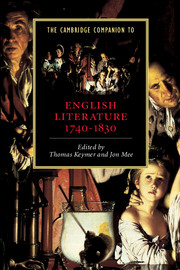Book contents
- Frontmatter
- Part I Contexts and modes
- 1 Readers, writers, reviewers, and the professionalization of literature
- 2 Criticism, taste, aesthetics
- 3 Literature and politics
- 4 Literature, national identity, and empire
- 5 Sensibility
- 6 Theatrical culture
- 7 Gothic
- Part II Writers, circles, traditions
- Index
- Series list
7 - Gothic
from Part I - Contexts and modes
Published online by Cambridge University Press: 28 May 2006
- Frontmatter
- Part I Contexts and modes
- 1 Readers, writers, reviewers, and the professionalization of literature
- 2 Criticism, taste, aesthetics
- 3 Literature and politics
- 4 Literature, national identity, and empire
- 5 Sensibility
- 6 Theatrical culture
- 7 Gothic
- Part II Writers, circles, traditions
- Index
- Series list
Summary
In Richard Hurd's 'Dialogue on the Age of Queen Elizabeth', the third of his Moral and Political Dialogues (1760), the figure of Mr Addison states that the Gothic ruins of Kenilworth Castle at once awaken 'an indignation against . . . the tyranny of those wretched times', and foster 'a generous pleasure in . . . the happiness we enjoy under a juster and more equal government'. For Addison's antagonist Dr Arbuthnot, by contrast, Kenilworth offers the aura of a heroic past, and a 'memorial of the virtue, industry [and] ingenuity of our ancestors'. The Gothic in Hurd's dialogue provides a differential by which the consequences of economic, political, and social change might be assessed. Adapting the long-standing view of the Goths as destroyers of classical Rome, innumerable eighteenth-century writers - in a similar way to Hurd's Addison - represented the Gothic past as a distant epoch, on which the enlightened present could look back in complacent triumph. The Gothic past also retained a potential critical function in the period, however, standing - in Arbuthnot's terms - for what had been lost, or what was seen to be lacking, in the present. Given that the Gothic peoples who had repelled Roman invasion went on to settle in Britain, the Gothic could also be resorted to, in a wide variety of ways, as the fount of a native spirit of liberty, or even of an incipient democratic tradition. Hurd’s dialogue by no means exhausts the possible meanings and uses of this elusive term, but it helpfully points to the way in which the category of Gothic was invoked in different contexts, in order to serve different agendas. While sometimes referring specifically to the Goths themselves, constructions of the Gothic as a pseudo-historical period almost always offered in more general terms a reading of the past and its legacy.
- Type
- Chapter
- Information
- The Cambridge Companion to English Literature, 1740–1830 , pp. 119 - 136Publisher: Cambridge University PressPrint publication year: 2004
- 4
- Cited by



